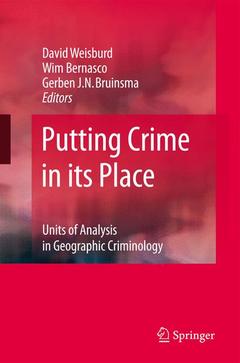Putting Crime in its Place, 2009 Units of Analysis in Geographic Criminology
Coordonnateurs : Weisburd David, Bernasco Wim, Bruinsma Gerben

Putting Crime in its Place: Units of Analysis in Geographic Criminology focuses on the units of analysis used in geographic criminology. While crime and place studies have been a part of criminology from the early 19th century, growing interest in crime places over the last two decades demands critical reflection on the units of analysis that should form the focus of geographic analysis of crime. Should the focus be on very small units such as street addresses or street segments, or on larger aggregates such as census tracts or communities? Academic researchers, as well as practical crime analysts, are confronted routinely with the dilemma of deciding what the unit of analysis should be when reporting on trends in crime, when identifying crime hot spots or when mapping crime in cities. In place-based crime prevention, the choice of the level of aggregation plays a particularly critical role. This peer reviewed collection of essays aims to contribute to crime and place studies by making explicit the problems involved in choosing units of analysis in geographic criminology. Written by renowned experts in the field, the chapters in this book address basic academic questions, and also provide real-life examples and applications of how they are resolved in cutting-edge research. Crime analysts in police and law enforcement agencies as well as academic researchers studying the spatial distributions of crime and victimization will learn from the discussions and tools presented.
David Weisburd is Walter E. Meyer Professor of Law and Criminal Justice and Director of the Institute of Criminology at the Hebrew University Faculty of Law, and Distinguished Professor of Administration of Justice at George Mason University. He is an elected Fellow of the American Society of Criminology and of the Academy of Experimental Criminology. He is also Co-Chair of the steering committee of the Campbell Collaboration Crime and Justice Group, a member of the Harvard University/National Institute of Justice Executive Session in Policing, and of the National Research Council Committee on Crime, Law and Justice. Professor Weisburd has a long interest in Crime and Place studies beginning with his involvement in a series of experimental studies of police interventions at crime places, including the Minneapolis Hot Spots Experiment, the Jersey City Drug Market Analysis Experiment and the Jersey City Violent Crime Hot Spots Experiment. Professor Weisburd is presently working on a book with Liz Groff and SueMing Yang that explores the varying factors that explain variation in developmental trends of crime at micro places over time that will be published by Oxford University Press. Professor Weisburd is author or editor of fifteen books and more than eighty scientific articles.
Wim Bernasco studied social psychology at Leiden University, and obtained a PhD in sociology at Utrecht University. His PhD thesis explored the interrelated nature of the occupational careers of spouses. Before joining the NSCR in 2000, he worked in different positions at various universities and at the research center of the Ministry of Justice. His current work focuses on spatial aspects of criminal activities, a broad area that encompasses a number of research questions. What drives variation in crime and delinquency between neighborhoods? Which effects do physical and soci
Well-defined focus on how one should go about choosing a level of aggregation in research of crime at places
Provides real-life examples and applications about how this is resolved in cutting edge research
Includes supplementary material: sn.pub/extras
Date de parution : 08-2009
Ouvrage de 254 p.
15.5x23.5 cm
Date de parution : 10-2008
Ouvrage de 254 p.
15.5x23.5 cm



